NASA’s New Planet Hunter Reveals A Sky Full Of Stars
NASA’s New Planet Hunter Reveals a Sky Full of Stars

NASA’s newest planet-hunting satellite — the Transiting Exoplanet Survey Satellite, or TESS for short — has just released its first science image using all of its cameras to capture a huge swath of the sky! TESS is NASA’s next step in the search for planets outside our solar system, called exoplanets.

This spectacular image, the first released using all four of TESS’ cameras, shows the satellite’s full field of view. It captures parts of a dozen constellations, from Capricornus (the Sea Goat) to Pictor (the Painter’s Easel) — though it might be hard to find familiar constellations among all these stars! The image even includes the Large and Small Magellanic Clouds, our galaxy’s two largest companion galaxies.
The science community calls this image “first light,” but don’t let that fool you — TESS has been seeing light since it launched in April. A first light image like this is released to show off the first science-quality image taken after a mission starts collecting science data, highlighting a spacecraft’s capabilities.

TESS has been busy since it launched from NASA’s Kennedy Space Center in Cape Canaveral, Florida. First TESS needed to get into position, which required a push from the Moon. After nearly a month in space, the satellite passed about 5,000 miles from the Moon, whose gravity gave it the boost it needed to get into a special orbit that will keep it stable and maximize its view of the sky.

During those first few weeks, we also got a sneak peek of the sky through one of TESS’s four cameras. This test image captured over 200,000 stars in just two seconds! The spacecraft was pointed toward the constellation Centaurus when it snapped this picture. The bright star Beta Centauri is visible at the lower left edge, and the edge of the Coalsack Nebula is in the right upper corner.

After settling into orbit, scientists ran a number of checks on TESS, including testing its ability to collect a set of stable images over a prolonged period of time. TESS not only proved its ability to perform this task, it also got a surprise! A comet named C/2018 N1 passed through TESS’s cameras for about 17 hours in July.
The images show a treasure trove of cosmic curiosities. There are some stars whose brightness changes over time and asteroids visible as small moving white dots. You can even see an arc of stray light from Mars, which is located outside the image, moving across the screen.

Now that TESS has settled into orbit and has been thoroughly tested, it’s digging into its main mission of finding planets around other stars. How will it spot something as tiny and faint as a planet trillions of miles away? The trick is to look at the star!
So far, most of the exoplanets we’ve found were detected by looking for tiny dips in the brightness of their host stars. These dips are caused by the planet passing between us and its star – an event called a transit. Over its first two years, TESS will stare at 200,000 of the nearest and brightest stars in the sky to look for transits to identify stars with planets.

TESS will be building on the legacy of NASA’s Kepler spacecraft, which also used transits to find exoplanets. TESS’s target stars are about 10 times closer than Kepler’s, so they’ll tend to be brighter. Because they're closer and brighter, TESS’s target stars will be ideal candidates for follow-up studies with current and future observatories.

TESS is challenging over 200,000 of our stellar neighbors to a staring contest! Who knows what new amazing planets we’ll find?
The TESS mission is led by MIT and came together with the help of many different partners. You can keep up with the latest from the TESS mission by following mission updates.
Make sure to follow us on Tumblr for your regular dose of space: http://nasa.tumblr.com.
More Posts from Nasa and Others
We Like Big Rockets and We Cannot Lie: Saturn V vs. SLS
On this day 50 years ago, human beings embarked on a journey to set foot on another world for the very first time.

At 9:32 a.m. EDT, millions watched as Apollo astronauts Neil Armstrong, Buzz Aldrin and Michael Collins lifted off from Launch Pad 39A at the Kennedy Space Center in Cape Canaveral, Florida, flying high on the most powerful rocket ever built: the mighty Saturn V.

As we prepare to return humans to the lunar surface with our Artemis program, we’re planning to make history again with a similarly unprecedented rocket, the Space Launch System (SLS). The SLS will be our first exploration-class vehicle since the Saturn V took American astronauts to the Moon a decade ago. With its superior lift capability, the SLS will expand our reach into the solar system, allowing astronauts aboard our Orion spacecraft to explore multiple, deep-space destinations including near-Earth asteroids, the Moon and ultimately Mars.

So, how does the Saturn V measure up half a century later? Let’s take a look.
Mission Profiles: From Apollo to Artemis
Saturn V

Every human who has ever stepped foot on the Moon made it there on a Saturn V rocket. The Saturn rockets were the driving force behind our Apollo program that was designed to land humans on the Moon and return them safely back to Earth.

Developed at our Marshall Space Flight Center in the 1960s, the Saturn V rocket (V for the Roman numeral “5”) launched for the first time uncrewed during the Apollo 4 mission on November 9, 1967. One year later, it lifted off for its first crewed mission during Apollo 8. On this mission, astronauts orbited the Moon but did not land. Then, on July 16, 1969, the Apollo 11 mission was the first Saturn V flight to land astronauts on the Moon. In total, this powerful rocket completed 13 successful missions, landing humans on the lunar surface six times before lifting off for the last time in 1973.
Space Launch System (SLS)

Just as the Saturn V was the rocket of the Apollo generation, the Space Launch System will be the driving force behind a new era of spaceflight: the Artemis generation.

During our Artemis missions, SLS will take humanity farther than ever before. It is the vehicle that will return our astronauts to the Moon by 2024, transporting the first woman and the next man to a destination never before explored – the lunar South Pole. Over time, the rocket will evolve into increasingly more powerful configurations to provide the foundation for human exploration beyond Earth’s orbit to deep space destinations, including Mars.
SLS will take flight for the first time during Artemis 1 where it will travel 280,000 miles from Earth – farther into deep space than any spacecraft built for humans has ever ventured.
Size: From Big to BIGGER
Saturn V

The Saturn V was big.
In fact, the Vehicle Assembly Building at Kennedy Space Center is one of the largest buildings in the world by volume and was built specifically for assembling the massive rocket. At a height of 363 feet, the Saturn V rocket was about the size of a 36-story building and 60 feet taller than the Statue of Liberty!
Space Launch System (SLS)

Measured at just 41 feet shy of the Saturn V, the initial SLS rocket will stand at a height of 322 feet. Because this rocket will evolve into heavier lift capacities to facilitate crew and cargo missions beyond Earth’s orbit, its size will evolve as well. When the SLS reaches its maximum lift capability, it will stand at a height of 384 feet, making it the tallest rocket in the world.
Power: Turning Up the Heat
Saturn V
For the 1960s, the Saturn V rocket was a beast – to say the least.
Fully fueled for liftoff, the Saturn V weighed 6.2 million pounds and generated 7.6 million pounds of thrust at launch. That is more power than 85 Hoover Dams! This thrust came from five F-1 engines that made up the rocket’s first stage. With this lift capability, the Saturn V had the ability to send 130 tons (about 10 school buses) into low-Earth orbit and about 50 tons (about 4 school buses) to the Moon.
Space Launch System (SLS)

Photo of SLS rocket booster test
Unlike the Saturn V, our SLS rocket will evolve over time into increasingly more powerful versions of itself to accommodate missions to the Moon and then beyond to Mars.
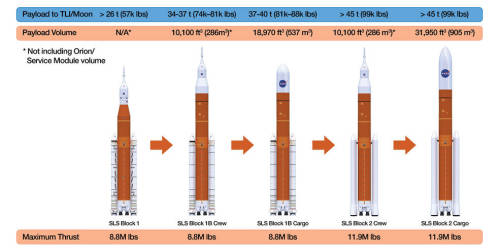
The first SLS vehicle, called Block 1, will weigh 5.75 million pounds and produce 8.8 million pounds of thrust at time of launch. That’s 15 percent more than the Saturn V produced during liftoff! It will also send more than 26 tons beyond the Moon. Powered by a pair of five-segment boosters and four RS-25 engines, the rocket will reach the period of greatest atmospheric force within 90 seconds!

Following Block 1, the SLS will evolve five more times to reach its final stage, Block 2 Cargo. At this stage, the rocket will provide 11.9 million pounds of thrust and will be the workhorse vehicle for sending cargo to the Moon, Mars and other deep space destinations. SLS Block 2 will be designed to lift more than 45 tons to deep space. With its unprecedented power and capabilities, SLS is the only rocket that can send our Orion spacecraft, astronauts and large cargo to the Moon on a single mission.
Build: How the Rockets Stack Up
Saturn V

The Saturn V was designed as a multi-stage system rocket, with three core stages. When one system ran out of fuel, it separated from the spacecraft and the next stage took over. The first stage, which was the most powerful, lifted the rocket off of Earth’s surface to an altitude of 68 kilometers (42 miles). This took only 2 minutes and 47 seconds! The first stage separated, allowing the second stage to fire and carry the rest of the stack almost into orbit. The third stage placed the Apollo spacecraft and service module into Earth orbit and pushed it toward the Moon. After the first two stages separated, they fell into the ocean for recovery. The third stage either stayed in space or crashed into the Moon.
Space Launch System (SLS)
Much like the Saturn V, our Space Launch System is also a multi-stage rocket. Its three stages (the solid rocket boosters, core stage and upper stage) will each take turns thrusting the spacecraft on its trajectory and separating after each individual stage has exhausted its fuel. In later, more powerful versions of the SLS, the third stage will carry both the Orion crew module and a deep space habitat module.
A New Era of Space Exploration
Just as the Saturn V and Apollo era signified a new age of exploration and technological advancements, the Space Launch System and Artemis missions will bring the United States into a new age of space travel and scientific discovery.
Join us in celebrating the 50th anniversary of the Apollo 11 Moon landing and hear about our future plans to go forward to the Moon and on to Mars by tuning in to a special two-hour live NASA Television broadcast at 1 p.m. ET on Friday, July 19. Watch the program at www.nasa.gov/live.
Make sure to follow us on Tumblr for your regular dose of space: http://nasa.tumblr.com.
Is it at all possible to send a drone into a black hole and collect the data of what it’s like inside? If not, how close do you we are to possibly achieving that?
Coffee in Space: Keeping Crew Members Grounded in Flight
Happy National Coffee Day, coffee lovers!
On Earth, a double shot mocha latte with soymilk, low-fat whip and a caramel drizzle is just about as complicated as a cup of coffee gets. Aboard the International Space Station, however, even just a simple cup of black coffee presents obstacles for crew members.

Understanding how fluids behave in microgravity is crucial to bringing the joys of the coffee bean to the orbiting laboratory. Astronaut Don Pettit crafted a DIY space cup using a folded piece of overhead transparency film. Surface tension keeps the scalding liquid inside the cup, and the shape wicks the liquid up the sides of the device into the drinker’s mouth.

The Capillary Beverage investigation explored the process of drinking from specially designed containers that use fluid dynamics to mimic the effect of gravity. While fun, this study could provide information useful to engineers who design fuel tanks for commercial satellites!

The capillary beverage cup allows astronauts to drink much like they would on Earth. Rather than drinking from a shiny bag and straw, the cup allows the crew member to enjoy the aroma of the beverage they’re consuming.

On Earth, liquid is held in the cup by gravity. In microgravity, surface tension keeps the liquid stable in the container.

The ISSpresso machine brought the comforts of freshly-brewed coffees and teas to the space station. European astronaut Samantha Cristoforetti enjoyed the first cup of espresso brewed using the ISSpresso machine during Expedition 43.


Now, during Expedition 53, European astronaut Paolo Nespoli enjoys the same comforts.

Astronaut Kjell Lindgren celebrated National Coffee Day during Expedition 45 by brewing the first cup of hand brewed coffee in space.

We have a latte going on over on our Snapchat account, so give us a follow to stay up to date! Also be sure to follow @ISS_Research on Twitter for your daily dose of space station science.
Make sure to follow us on Tumblr for your regular dose of space: http://nasa.tumblr.com.
Studying the tiny life of phytoplankton
Phytoplankton. Have you ever heard of them? At NASA, these tiny organisms are kind of a big deal.

Biodiversity in the ocean is a delicate, but essential balance for life on Earth. One way NASA studies this balance is by observing phytoplankton – microalgae that contain chlorophyll, require light to grow, and form the base of the marine food chain.
Phytoplankton even have an essential role in an upcoming NASA mission.
This mission is called PACE- "Plankton, Aerosol, Cloud, ocean Ecosystem.” It will reveal interactions between the ocean and atmosphere, including how they exchange carbon dioxide and how atmospheric aerosols might fuel phytoplankton growth in the surface ocean.
Here are four areas main areas the mission will focus on as part of #WorldOceansMonth.
1. Harmful algal blooms: Not the good kind of bloom
The word “bloom” sounds pretty, but harmful algal blooms (HABs) are anything but.
When an ocean region is rich in nutrients – think of it as adding fertilizer to the ocean - phytoplankton such as cyanobacteria multiply much faster than usual. This is called a “bloom.”
Some blooms are smelly and ugly but harmless. Others, like HABs, release toxins into the water that can make fish, shellfish, turtles and even humans very sick.
NASA’s PACE mission will help track phytoplankton growth and ocean health to make sure all of us stay healthy, balanced and blooming. In a good way.
2. Aerosols: The sea-sky connection
What do phytoplankton and clouds have in common? More than you might think.
PACE will also study aerosols, which are any particles or droplets suspended in our atmosphere. Humans create aerosols, like soot or car exhaust, but some phytoplankton release aerosols too.
For example, dust – also an aerosol – can blow into the ocean, depositing iron that helps phytoplankton grow. These phytoplankton then release dimethyl sulfide, a gas that turns into an aerosol, which can influence how clouds form.
Whether the aerosols in our atmosphere come from the ocean or land, it’s important to know how they are impacting our environment. PACE will help clear up some of our questions about what is in our air.
3. Biodiversity: The more, the merrier
A healthy ocean supports healthy industries and economies, contributes to a healthy atmosphere and helps keep plants, animals and humans healthy and happy. One key to a healthy, balanced ocean is lots of biodiversity.
Biodiversity means having a wide variety of plant and animal species in an ecosystem. It’s important to have many different species of phytoplankton, because each species plays a different role in processing carbon, providing food for tiny animals, and keeping the ocean healthy.
PACE will track the size and movements of phytoplankton populations from space to help our seas stay diverse and bountiful.
4. Fisheries: Phytoplankton feed fish feed friends
One simple reason for tracking the ocean’s health is that fish eat tiny animals that eat phytoplankton, and people eat fish.
Fisheries and aquaculture support about 12 percent of jobs around the world, including employing more than 3 million people in the United States. By better understanding our ocean’s health and how it might change in the future, we can make predictions about impacts to our economies and food supply.
To learn more about phytoplankton, visit our website.
Make sure to follow us on Tumblr for your regular dose of space: http://nasa.tumblr.com.
What’s Up for April 2016?
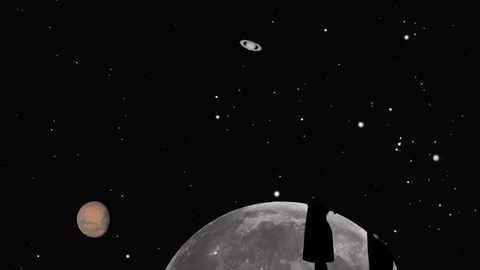
Jupiter, Mars, the Lyrid meteor shower and 2016’s best views of Mercury are all visible in the sky this month.
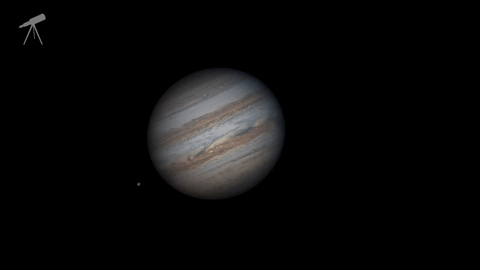
Jupiter, where our Juno mission will begin orbiting on July 4, continues to shine almost as brightly this month as last. And eagle-eyed telescope viewers will see a transit, a shadow transit, an occultation and an eclipse of Jupiter’s moons- all in one night: April 6-7.
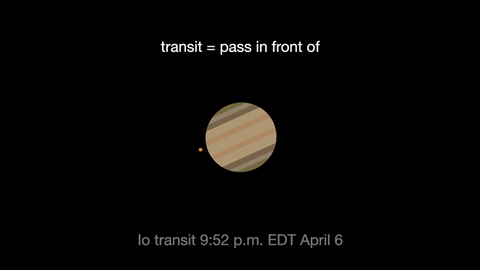
Io transits first, crossing the planet beginning at 9:52 p.m. EDT. It’s shadow can be seen less than an hour later.
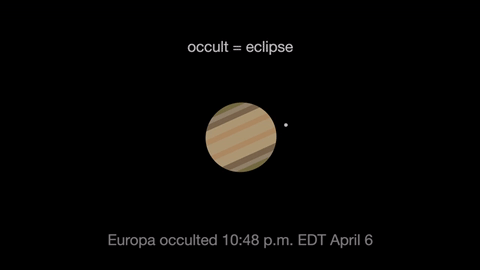
Next Jupiter occults, or eclipses, Europa as Europa slips behind the giant planet at 10:48 p.m. EDT. At 3 a.m. Europa reappears from its eclipse, dramatically leaving the shadow of Jupiter.
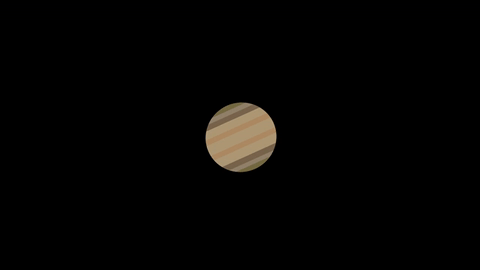
Ganymede transits the planet beginning at 1:01 EDT April 7.
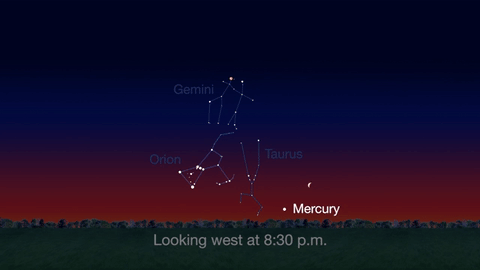
Check out the other planets in April, too! Mercury is always a challenging object to view, but this month you can spot it after sunset about 10 degrees above the horizon. Through a telescope you can see its phase. It will appear like a tiny crescent moon, with about 1/3 of its disk illuminated.
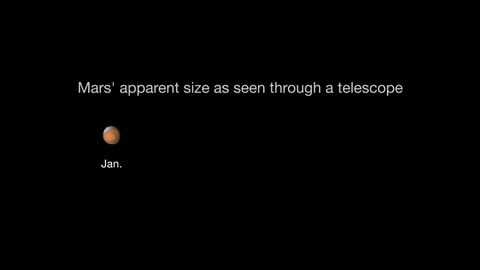
Mars is finally visible before midnight this month. It rises in the southeast at about 10 p.m. by the end of April. The best observing of Mars will be when it is highest in the sky. This means a few hours before dawn. Its brightness and apparent size increase dramatically this month. By month’s end, Mars appears nearly twice as bright as at the beginning of the month.
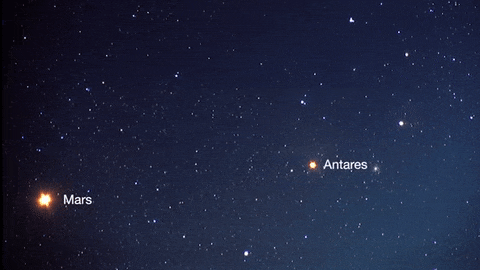
About mid-month you’ll see Mars near its rival in the sky: the similar-colored red supergiant star Antares. The name “Antares” means “equal to or rival of Mars”.
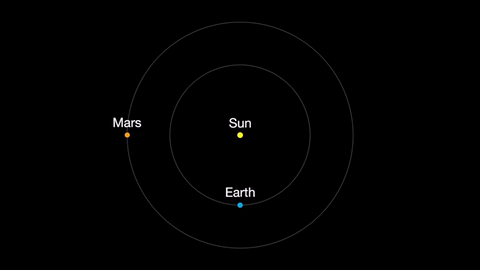
Earth moves almost twice as fast as Mars does, so it often passes Mars in their race around the sun. This causes “retrograde motion”: an illusion we see from our viewpoint on Earth.
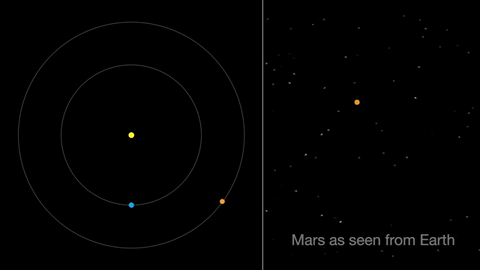
Retrograde motion happens as Earth catches up to Mars, causing Mars to appear slow to slow its eastward motion against the stars. After a few days, when Earth has overtaken Mars, the Red Planet seems to move westward. Eventually, Earth moves far enough around its orbit that Mars appears to be moving eastward again.
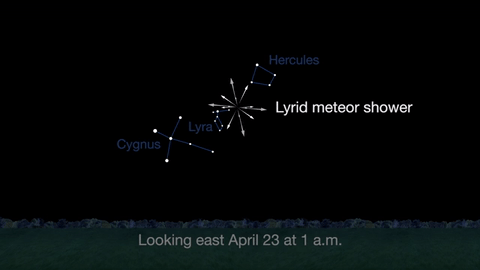
April features one meteor shower, the Lyrids. This year the Lyrids are marred by the full moon. The best time to view will be just before dawn on April 23, when the constellation Lyra is overhead and the moon will be near to setting.
With all of these great things to spot in the sky this month, be sure to get outside and look up!
Make sure to follow us on Tumblr for your regular dose of space: http://nasa.tumblr.com
What was your fav sci-fi show/book/movie growing up?
I was a big fan of Doctor Who, and of course Star Trek!
What’s Up For September 2018?
Outstanding views Venus, Jupiter, Saturn and Mars with the naked eye!

You'll have to look quickly after sunset to catch Venus. And through binoculars or a telescope, you'll see Venus's phase change dramatically during September - from nearly half phase to a larger thinner crescent!

Jupiter, Saturn and Mars continue their brilliant appearances this month. Look southwest after sunset.

Use the summer constellations help you trace the Milky Way.

Sagittarius: where stars and some brighter clumps appear as steam from the teapot.

Aquila: where the Eagle's bright Star Altair, combined with Cygnus's Deneb, and Lyra's Vega mark the Summer Triangle.

Cassiopeia, the familiar "w"- shaped constellation completes the constellation trail through the Summer Milky Way. Binoculars will reveal double stars, clusters and nebulae.

Between September 12th and the 20th, watch the Moon pass from near Venus, above Jupiter, to the left of Saturn and finally above Mars!

Both Neptune and brighter Uranus can be spotted with some help from a telescope this month.

Look at about 1:00 a.m. local time or later in the southeastern sky. You can find Mercury just above Earth's eastern horizon shortly before sunrise. Use the Moon as your guide on September 7 and 8th.

And although there are no major meteor showers in September, cometary dust appears in another late summer sight, the morning Zodiacal light. Try looking for it in the east on moonless mornings very close to sunrise. To learn more about the Zodiacal light, watch "What's Up" from March 2018.

Watch the full What’s Up for September Video:
There are so many sights to see in the sky. To stay informed, subscribe to our What’s Up video series on Facebook.
Make sure to follow us on Tumblr for your regular dose of space: http://nasa.tumblr.com
Solar System: Life Among the Stars
Let us lead you on a journey of our solar system. Here are some things to know this week:
1. Amateur" Means "One Who Loves"

We release thousands of breathtaking solar system images every year and not all of them are the exclusive result of work by scientists. Amateur image processors around the world take raw data from deep space missions and turn it into striking visuals.
Amateur images from Cassini
Get current unprocessed images
2. Prepare to Weigh Anchor

OSIRIS-REx, our first spacecraft destined to rendezvous with, study and return a sample of an asteroid, will launch. The mission to asteroid Bennu will yield the largest sample returned from space since the Apollo era. Tune in four our media briefing about OSIRIS-REx for 2 p.m. EDT on Aug. 17.
Learn more and tune in.
3. Out for a Walk

Join us for live coverage on Aug. 19 as our astronauts Jeff Williams and Kate Rubins install a new gateway for American commercial crew spacecraft at the International Space Station.
Live coverage of the spacewalk.
4. The Weather Out There

Aug. 17 marks 50 years since the launch of Pioneer 7, a robotic spacecraft that lived up to its name by exploring the solar magnetic field, the solar wind and cosmic rays in deep space. Along with Pioneers 6, 8, and 9, the spacecraft formed a ring of solar weather stations spaced along Earth's orbit. Measurements by the craft were used to predict solar storms for organizations ranging from commercial airlines to power companies.
Learn more.
5. Destination: The Red Planet

The European Space Agency's ExoMars/Trace Gas Orbiter mission to Mars performed a critical engine burn to keep it on course. The maneuver was a success, and ExoMars remains on target for an October arrival.
Learn more.
Discover the full list of 10 things to know about our solar system this week HERE.
Make sure to follow us on Tumblr for your regular dose of space: http://nasa.tumblr.com
Solar System: Things To Know This Week
Weather permitting, you can observe the Moon most nights, unless it's a new moon, when the lighted side of the Moon faces away from Earth. The Moon is by far the brightest object in the night sky and there's plenty to see. But this week is special...

...October 28 is International Observe the Moon Night (also known as InOMN).
Here's all you need to know to join in and celebrate:
1. One Planet. One Moon. One Night.

Everyone on Earth is invited to join the celebration by hosting or attending an InOMN event and uniting on one day each year to look at and learn about the Moon together.
2. What's Up?

October's night skies are full of sights, from the first quarter Moon on InOMN to Saturn making a cameo appearance above the Moon October 23 and 24. Watch our What's Up video for details.
3. Be Social

Hundreds of events are planned around the globe. Click the top link on this page for a handy map. You can also register your own event.
4. Don't Just Stand There

Here are some activities for enhanced Moon watching.
5. Impress Your Friends with Moon Knowledge

Download InOMN flyers and handouts, Moon maps and even some pre-made presentations. There's even a certificate to mark your participation.
6. Guide to the Face of the Moon

Almost dead center on the Earth-facing side of the Moon is the Surveyor 6 robotic spacecraft impact side. Apollo 12 and 14 are a bit to the left. And Apollo 11 - the first steps on the moon - are to the right. This retro graphic tells the whole story.
7. Moon Shots

NASA photographers have done some exceptional work capturing views of the Moon from Earth. Here are a few galleries:
You can't have a solar eclipse without the Moon.
The 2016 "Supermoon" was pretty spectacular.
The Moon gets eclipsed, too.
That IS a Moon - AND the International Space Station.
The Moon is always a great photo subject.
Some spooky shots of the 2014 "Supermoon."
And 2013.
Tips from a NASA pro for photographing the Moon.
8. Walking on the Moon

Twelve human beings walked on the face of the Moon. Here are some of the best shots from the Apollo program.
9. Moon Watch

Our Lunar Reconnaissance Orbiter is up there right now, mapping the moon and capturing some spectacular high-resolution shots.
10. Keep Exploring

Make our Moon portal your base for further lunar exploration.
Check out the full version of ‘Ten Things to Know This Week’ HERE.
Make sure to follow us on Tumblr for your regular dose of space: http://nasa.tumblr.com.
Solar System: Things to Know This Week
Be a scientist for a day, solstice on the Red Planet, historic launches and more!

1. Scientist for a Day!
This year's Scientist for a Day essay contest was announced last week. Write an essay on one of the three images above. Essays are due in Feb. 2017. Students in grades 5-12 in U.S. schools, after-school and home-school programs, scout troops and museum programs are eligible to participate.
+ Learn more

2. Tuesday is Winter Solstice on Mars' Northern Hemisphere
Mars' orbit is much more eccentric than Earth's. The winters in the northern hemisphere are warm and short, as Mars is near perihelion—closer to the sun. This means that the winters in the southern hemisphere are long and cold.
+ Read Mars: The Other Terrestrial Planet
+ Seasons on Mars (Malin Space Science Systems)

3. Launch-iversaries!
We’re celebrating two launch anniversaries. Before Curiosity. Before Spirit and Opportunity, there was Pathfinder and the hardy Sojourner rover, launched on Dec. 4, 1996. Pathfinder was a demonstration of the technology necessary to deliver a lander and a free-ranging robotic rover to the surface of Mars in a cost-effective and efficient manner. The lander, formally named the Carl Sagan Memorial Station following its successful touchdown, and the rover, named Sojourner after American civil rights crusader Sojourner Truth, both outlived their design lives — the lander by nearly three times, and the rover by 12 times! We continued the tradition with Spirit and Opportunity. Now there is the Mars Science Laboratory (with the Curiosity rover in stowage), which was launched on Nov. 26, 2011. It landed successfully in Gale Crater at 1:31 am EDT on Aug. 6, 2012.
+ Go Back in Time
+ Video: Where Were You When Curiosity Landed on Mars?

4. Mars Ice Deposit Holds as Much Water as Lake Superior
Water ice makes up half or more of an underground layer in a large region of Mars, about halfway from the equator to the north pole. The amount of water in this deposit—assessed using a radar aboard NASA's Mars Reconnaissance Orbiter—is about as much as in Lake Superior.
+ Read More

5. A Little Bit of History
Finally, it’s been seven years since Cassini caught one of its most stunning views of the plume on Saturn's moon Enceladus.
+ Read More
Discover the full list of 10 things to know about our solar system this week HERE.
Make sure to follow us on Tumblr for your regular dose of space: http://nasa.tumblr.com
-
 liondrakes liked this · 3 months ago
liondrakes liked this · 3 months ago -
 ginathethundergoddess liked this · 6 months ago
ginathethundergoddess liked this · 6 months ago -
 colinkloecker liked this · 1 year ago
colinkloecker liked this · 1 year ago -
 eden-eff liked this · 2 years ago
eden-eff liked this · 2 years ago -
 mikev999 liked this · 3 years ago
mikev999 liked this · 3 years ago -
 frankievelvet7 liked this · 4 years ago
frankievelvet7 liked this · 4 years ago -
 rainyzinefarmwobbler liked this · 4 years ago
rainyzinefarmwobbler liked this · 4 years ago
Explore the universe and discover our home planet with the official NASA Tumblr account
1K posts